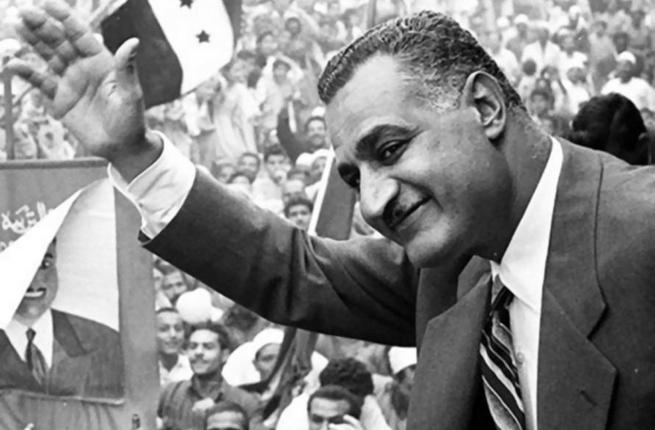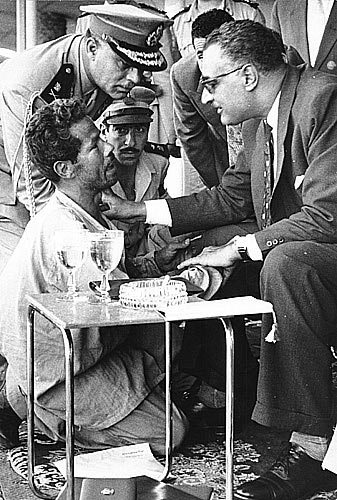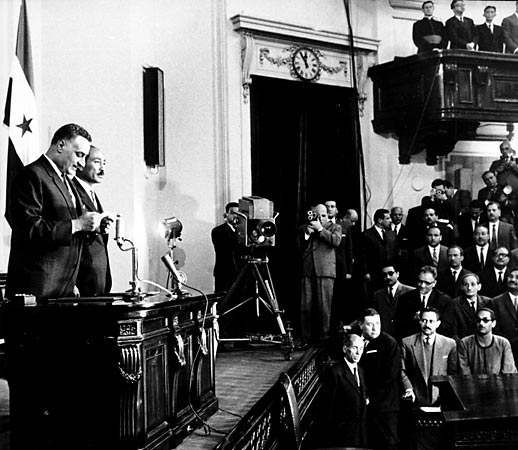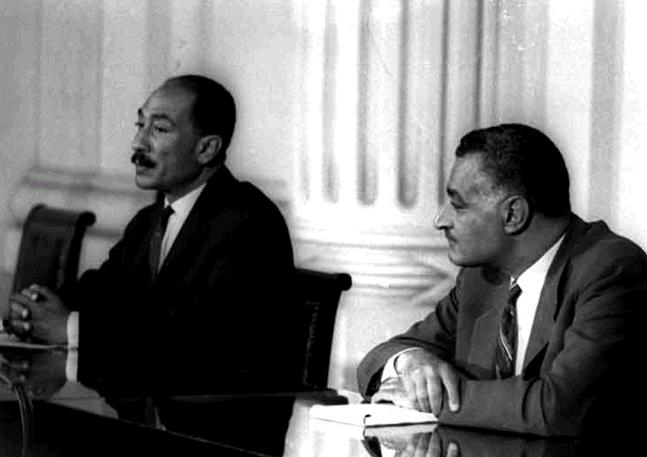As’ad AbuKhalil confronts the negative press surrounding a man whose influence, 50 years after his death, is still rattling Gulf media empires and reactionary forces in the West.

Gamal `Abdul-Nasser waving to crowds in Mansoura, Egypt, 1960. (Wikimedia Commons)
By As`ad AbuKhalil
Special to Consortium News
 Since the death of Muhammad, only two leaders in Arab lands have galvanized nearly the entire Arab population: the 12th century’s Saladin (of Kurdish descent) and Gamal `Abdul-Nasser.
Since the death of Muhammad, only two leaders in Arab lands have galvanized nearly the entire Arab population: the 12th century’s Saladin (of Kurdish descent) and Gamal `Abdul-Nasser.
Nasser, who died in September 1970, marked the era in which he lived. We still in Arabic and English speak of the Nasserist era, the Nasserist tide (al-madd an-nasiri) and of Nasserism. And like Muhammad before him, no figure in Arab history was more maligned, caricatured and vilified than Nasser — in the West and in the Eastern capitals of Gulf Arab despots. The Saudi regime officially declared Nasser a kafir, or infidel.
Millions of Western and Gulf dollars have been spent on the relentless propaganda campaign against him. The image of Nasser in Western media is strikingly different from the real man, who led the overthrow of the Egyptian monarchy, served as the country’s second president, was a socialist leader of the pan-Arab movement and a co-founder and leader of the Non-aligned Movement.
Please Contribute to Consortium News’
25th Anniversary Fall Fund Drive
One way to gauge his impact is by the persistence of his detractors. Fifty years after his death, Saudi regime media still devote pages upon pages to attack him and vilify him. Saudi leaders still act as if they have a score to settle; their propaganda still devotes a substantial section to attacks on Nasser and his legacy and refutation of his slogans and programs.
I was only 10 when Nasser died but my childhood memory is filled with his images. I remember that our school bus traveled through streets in Beirut that were filled with posters of him — I mean every street. Newscasts were basically a compilation of his statements, activities and meetings. Arab summit meetings were his creation and they were dominated by his larger-than-life persona. His charisma was such that he may have been the only person to ever upstage Che Guevara in photographs.
This is the only picture I know of in which Che Guevara is being overshadowed. pic.twitter.com/zrVfGcImXB
— asad abukhalil ???? ??? ???? (@asadabukhalil) September 29, 2020
I remember when he tried to resign in 1967 following Egypt’s defeat by Israel in the Six Days War, how thousands of people took to the street after dark, in their night clothes, urging him to rescind his resignation.
In Egypt, the demonstrations were much more massive and yet Anwar Sadat, his successor, and the right-wing media fabricated the story that the demonstrations were not spontaneous but “orchestrated.” Even Joel Beinin repeats this absurd claim in a recent article in The Jacobin.
Was the demonstration that I saw and heard at the age of 7 in Beirut also orchestrated, I wonder?
His death brought about the largest funeral in history (estimated to be over 5 million) and I don’t remember any adult around us who did not cry. Such was the looming presence of Nasser in our lives throughout the Arab world. Malcolm Kerr, in his chronicle of Arab political life in the 1950s and 1960s included his name in the subtitle: The Arab Cold War, Gamal ‘Abd al-Nasir and his rivals, 1958-1970.
He is the only Arab leader in the 20th century who gave his name to an “ism,” Nasserism, although the movement did not prosper or grow after his death because so much about it was inextricably linked to Nasser’s immense charisma.
Revolution

Gamal `Abdul-Nasser observing the Suez front with Egyptian officers during the 1968 War of Attrition. (Wikimedia Commons)
Nasser was the leader of a peaceful coup, which is known as “the Egyptian revolution” of 1952. But it acquired the name revolution not so much from the overthrow of the British-sponsored monarchy but from the thorough- going, radical transformation in Egyptian social, cultural, economic and political life. Its impact was such that many Arab coups of the 1950s, 1960s and 1970s were inspired by the example. Some of those coups succeeded, like in Libya and Sudan, while others, in Iraq and Morocco, did not.
It was such a transformative revolution that its impact was felt in every Arab country and permeated all aspects of culture: from music to film and literature. Imagine a time when even Saudi princes defected from their royal families and abandoned personal fortunes to join Nasser’s cause in Egypt. Prince Talal, a Saudi royal, and Prince Badr, the son of the founder of the Saudi kingdom, were among Nasser’s followers and formed The Free Princes Movement.
His influence rattled the pro-U.S. despots in the Gulf and North Africa and resulted in heavy Western and Israeli investment in the regime of his enemies.
For Nasser, the movement was revolutionary in a double sense of the word. It was against both local upper-class interests and Western colonial powers. One of his most famous slogans, was “Lift up your head, my brother, the era of colonialism is over.” (Beinin, in the article cited above, distorts the slogan by citing it in colloquial Arabic —while it is known in Classical Arabic — and by dropping the mention of colonialism, for some reason).
Nasser’s nationalization of the Suez Canal was one of the most significant acts of defiance against Western colonial powers in Arab history; his declaration catapulted him into regional and international prominence. Nasser became more than an Arab leader. He was a symbol of all developing countries and of liberation movements, which he supported.
Nasser’s political terminology shaped the era in which he lived and even the era which followed him. So much of the language surrounding the Arab-Israeli conflict is from his own rhetoric. The insistence on a “just and comprehensive” peace was a cornerstone of Nasser’s approach. And even after his defeat in 1967, he did not surrender. Instead he embarked on major restructuring of the Egyptian army. The strong performance of the Egyptian army in the first few days of the 1973 October War was due to the preparations undertaken under Nasser, although Sadat’s management of the war ultimately led to Israeli victory.
Social Justice

Gamal `Abdul-Nasser speaking to a homeless Egyptian man and offering him a job, after the man was found sleeping below the stage where Nasser was seated, 1959. (Al-Ahram Weekly, Wikimedia Commons)
The extent of Nasser’s changes can be measured by the plight of the Egyptian masses (workers and peasants).
During the monarchy, education and hospitalization was the privilege of the rich elite. My late father attended the law school of Cairo University in the 1940s (it was named Fu’ad I University, after the king) and students at the time were exclusively drawn from elite backgrounds, in Egypt and the Arab world.
After 1952, Nasser made education (at all levels) free and available for all Egyptians. He even established the pan-Arab University of Beirut, which remains in existence. Medical care under Nasser was free.
The backbone of the Nasser regime were the working people who benefited greatly from its social reforms. While eliminating the privileges and advantages of the ruling elite, Nasser launched agrarian reforms and made land available for peasants who hailed from families which had not owned soil in centuries.
There is a story of Nasser visiting a factory and seeing workers eating onions and bread for lunch. He was so disturbed that he demanded a major budget restructuring to change the food staple of industrial workers. Nasser’s government was first among Arab governments to publish paperback editions of books to spread knowledge among the masses. Book printing in Beirut and Cairo, the centers of Arab publishing, was hitherto directed only at the privileged few.
Democracy

Gamal `Abdul-Nasser swearing in for second term as Egypt’s president, March 25, 1965. (Al-Ahram Weekly, Wikimedia Commons)
Nasser’s government is often criticized for its lack of democracy. He believed in people’s representation and he put, for the first time in Egyptian history, representatives of workers and peasants in the Egyptian parliament which had been a club of the rich elite.
It is true that Nasser’s regime was not styled after Western capitalist democracies, but where were those democracies in the region at the time? Were U.S. allies in North Africa and in the Gulf democracies? No.
To this day, Gulf despots and their propagandists level the charge of anti-democracy against Nasser. Egypt under Nasser held regular elections and the vote for Nasser as president can’t be disputed. It is true that he banned political parties but the slogan after 1967, “No Voice above that of the Battle,” was intended as a warning to the reactionary elements in Egypt who wished (on behalf of Gulf and Western powers) to seize the opportunity of the defeat in 1967 to undermine the regime. Furthermore, the slogan was intended to set the rebuilding of the Egyptian army and preparation for the future battle with Israel as the top priority.
And despite all the propaganda about Nasser’s tyranny, the number of executions under his rule, from 1952 to 1970, amount to 11 (according to the count by Nasser’s foremost expert, Kamal Khalaf Al-Tawil). Most of them belonged to the Muslim Brotherhood who — at the behest of Gulf despots and Western powers — were trying to overthrow the regime. They tried to assassinate Nasser. Those same Muslim fundamentalists sought refuge in the Gulf where they formed the militant Islamist ideologies and movements that we hear (and complain) about to this very day. Iran and Saudi Arabia execute more people per month, than Nasser ordered executed in his entire reign.
1967
Nasser is often, and rightly, blamed for the 1967 defeat. The defeat was quite catastrophic in Arab contemporary history and it expanded not only the size of the Israeli occupation state but also its reach into the Arab East and North Africa.
But what we now know about the period (especially from Hazem Kandil’s Soldiers, Spies, and Statesmen: Egypt’s Road to Revolt) sheds new light on the reasons for the actions that preceded the Israeli attack.

Anwar Sadat (left) and Gamal `Abdul-Nasser in the National Assembly, 1964. (Wikimedia Commons)
The silly theory that Nasser allowed the buffoon, `Abdul-Hakim `Amer (then chief of the Egyptian army) to manage the armed forces simply because he was his “buddy” has been put to rest. We now know that Nasser was simply unable to remove `Amer who controlled the Egyptian army and threatened his own leadership.
Far from being his buddy, `Amer created a power center and prevented Nasser’s plan to professionalize the Egyptian army. `Amer was more a rival to Nasser, than an ally. Nasser’s real control of the Egyptian army spanned only from 1967 to his death in 1970, and the period was characterized by the masterful performance of the Egyptian army during the War of Attrition.
This is not a nostalgic return to the past, nor an attempt to bring back a ghost from a previous century. But the history of the last century has been written by the reactionary forces in the West in cahoots with the media empires of Gulf despots.
Sadat (clearly at the behest of his American sponsors) launched a massive (Gulf-funded) campaign to distort the legacy of Nasser and to malign his character (a man who was incorruptible, and who left barely anything to his family who relied on a government pension to survive). It is disturbing that his maligning of Nasser has influenced the thinking of some Arab leftists, and even leftists in the West.
As’ad AbuKhalil is a Lebanese-American professor of political science at California State University, Stanislaus. He is the author of the “Historical Dictionary of Lebanon” (1998), “Bin Laden, Islam and America’s New War on Terrorism (2002), and “The Battle for Saudi Arabia” (2004). He tweets as@asadabukhalil
The views expressed are solely those of the author and may or may not reflect those of Consortium News.
Please Contribute to Consortium News’
25th Anniversary Fall Fund Drive
Donate securely with
Click on ‘Return to PayPal’ here.
Or securely by credit card or check by clicking the red button:


